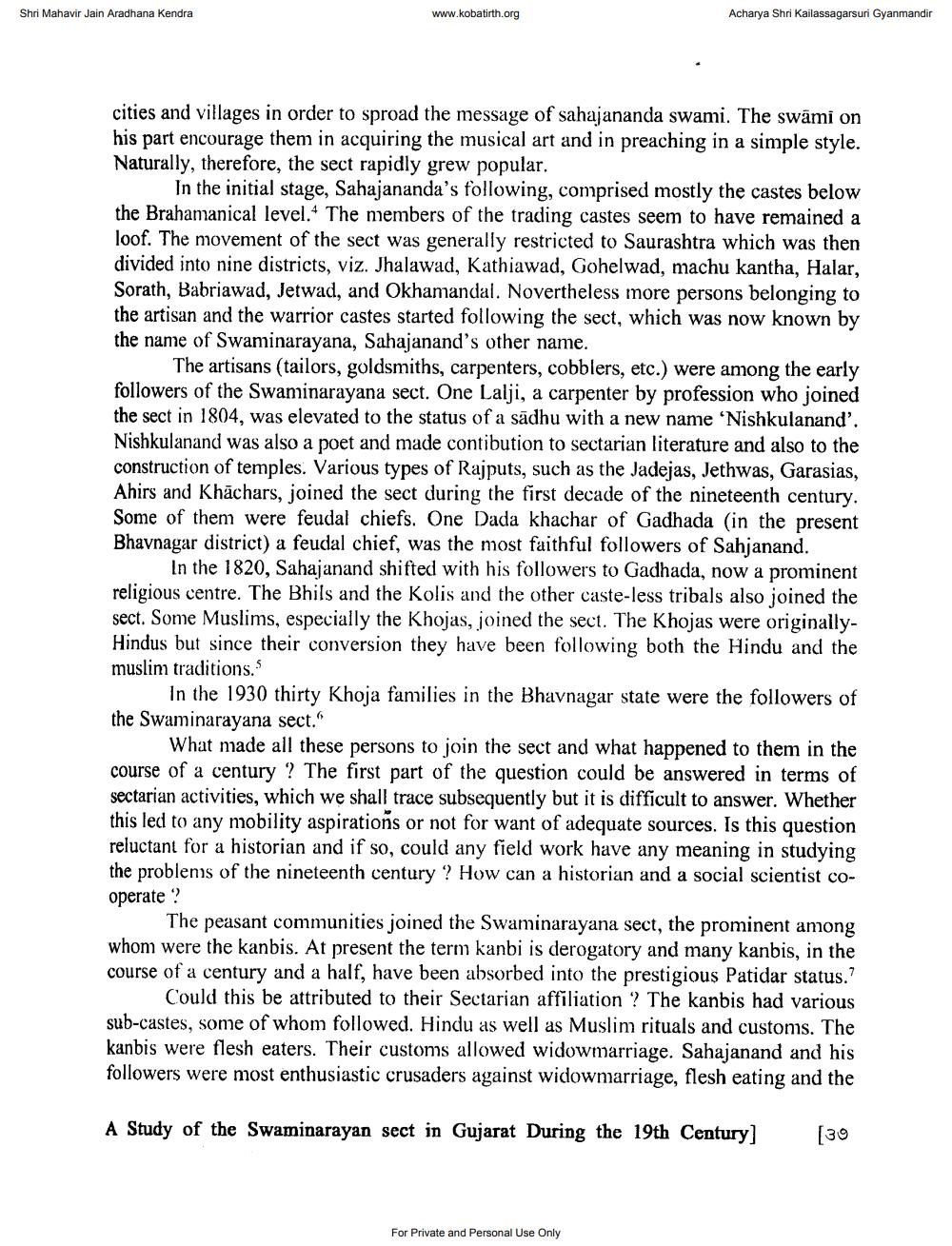________________
Shri Mahavir Jain Aradhana Kendra
www.kobatirth.org
Acharya Shri Kailassagarsuri Gyanmandir
cities and villages in order to sproad the message of sahajananda swami. The swāmi on his part encourage them in acquiring the musical art and in preaching in a simple style. Naturally, therefore, the sect rapidly grew popular.
In the initial stage, Sahajananda's following, comprised mostly the castes below the Brahamanical level. The members of the trading castes seem to have remained a loof. The movement of the sect was generally restricted to Saurashtra which was then divided into nine districts, viz. Jhalawad, Kathiawad, Gohelwad, machu kantha, Halar, Sorath, Babriawad, Jetwad, and Okhamandal. Novertheless more persons belonging to the artisan and the warrior castes started following the sect, which was now known by the name of Swaminarayana, Sahajanand's other name.
The artisans (tailors, goldsmiths, carpenters, cobblers, etc.) were among the early followers of the Swaminarayana sect. One Lalji, a carpenter by profession who joined the sect in 1804, was elevated to the status of a sādhu with a new name 'Nishkulanand'. Nishkulanand was also a poet and made contibution to sectarian literature and also to the construction of temples. Various types of Rajputs, such as the Jadejas, Jethwas, Garasias, Ahirs and Khāchars, joined the sect during the first decade of the nineteenth century. Some of them were feudal chiefs. One Dada khachar of Gadhada (in the present Bhavnagar district) a feudal chief, was the most faithful followers of Sahjanand.
In the 1820, Sahajanand shifted with his followers to Gadhada, now a prominent religious centre. The Bhils and the Kolis and the other caste-less tribals also joined the sect. Some Muslims, especially the Khojas, joined the sect. The Khojas were originallyHindus but since their conversion they have been following both the Hindu and the muslim traditions.
In the 1930 thirty Khoja families in the Bhavnagar state were the followers of the Swaminarayana sect."
What made all these persons to join the sect and what happened to them in the course of a century ? The first part of the question could be answered in terms of sectarian activities, which we shall trace subsequently but it is difficult to answer. Whether this led to any mobility aspirations or not for want of adequate sources. Is this question reluctant for a historian and if so, could any field work have any meaning in studying the problens of the nineteenth century? How can a historian and a social scientist cooperate?
The peasant communities joined the Swaminarayana sect, the prominent among whom were the kanbis. At present the term kanbi is derogatory and many kanbis, in the course of a century and a half, have been absorbed into the prestigious Patidar status.?
Could this be attributed to their Sectarian affiliation ? The kanbis had various sub-castes, some of whom followed. Hindu as well as Muslim rituals and customs. The kanbis were flesh eaters. Their customs allowed widowmarriage. Sahajanand and his followers were most enthusiastic crusaders against widowmarriage, flesh eating and the
A Study of the Swaminarayan sect in Gujarat During the 19th Century]
[39
For Private and Personal Use Only




